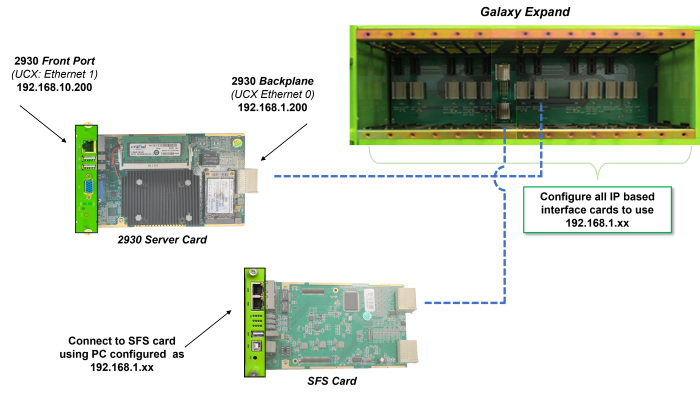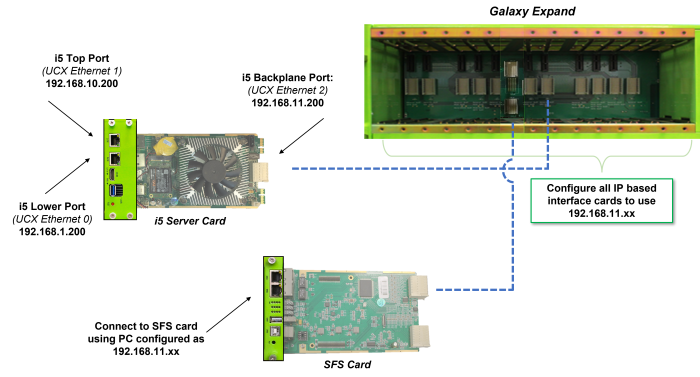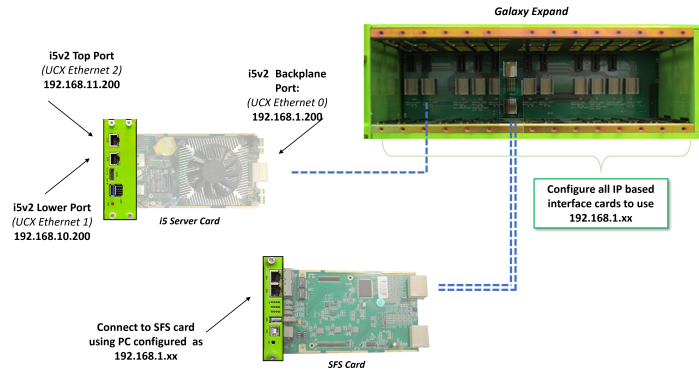Galaxy Expand - Standalone UCX Server Configuration
Standalone UCx Server Configuration
Galaxy Expand Hardware Requirements
Required cards
When deployed as a standalone UCx server, the configuration requires a Galaxy Expand Server Card. The choice of which Server card is based upon the number of extensions required or the number of simultaneous calls required for the call server. The capacities of the various server cards is described in Galaxy Expand - Platform Hardware. For details how to configure the UCx software running on either of the Server Cards, refer to the UCx Server documentation beginning in Section 3.
Optional Cards
Any of the available Telephony interface cards as described in Galaxy Expand - Platform Hardware can be configured in any of the ten remaining slots. Additional server cards can also be installed, but the multi-server card configurations are described in other application descriptions. Note that for an all IP based configuration with only IP telephones and SIP trunks, no telephony cards are required.
For details on how to configure the optional Telephony Interface Cards, refer to the following:
- DSM16p Card Configuration (Ethernet Enabled)
- PRI-1 Card Configuration (Ethernet Enabled)
- FXS 16-port Card Configuration (Ethernet Enabled)
- FXO 8-port Card Configuration (DAHDI Enabled)
2930 Server Card Network Connection and Configuration
Slot assignment for Required Cards
In most applications when deploying the Galaxy Expand as a standalone UCX server, the Galaxy Expand 2930 Server Card should be be installed in slot 7a as noted in Galaxy Expand - Platform Hardware. When the single slot 2930 Call Server card is used the corresponding "b" slot for that location should be covered with a blank card slot cover.
Default IP Addressing
When using a Galaxy Expand 2930 Server Card, there is a single ethernet interface on the server card itself labeled ETH, which by default is assigned an address of 192.168.10.200 and corresponds with Ethernet 1 setting in the UCX network settings. The Ethernet 0 UCX network setting of 192.168.1.200 is used on the backplane. This subnet is accessible by connecting to either ETH1 or ETH2 switch ports on the front of the SFS card.
All configuration of the 2930 Server Card parameters should be done in accordance with the UCX Network Parameters documentation. The instructions for configuring network interfaces in the UCX software are provided in Configure Second Network Port.

i5 Server Card (version 1) Network Connection and Configuration
Slot assignment for i5 Server Card
In most applications when deploying the Galaxy Expand as a standalone UCX server, the Galaxy Expand 2930 Server Card should be be installed in slot 7a as noted in Galaxy Expand - Platform Hardware. As the i5 Server card is a double-width design, the faceplate will cover both the a" and the corresponding "b" slot for that location.
Recommended IP Addressing
When using a Galaxy Expand i5 Server Card (Version 1), there are two ethernet interfaces on the server card itself, labeled WAN and LAN. The WAN port is assigned 192.168.1.200 and corresponds to the UCX Ethernet 0 settings, while the LAN port is assigned an address of 192.168.10.200 and corresponds with Ethernet 1 setting in the UCX network settings. The Ethernet 2 interface is used on the backplane and is assigned 192.168.11.200. This subnet is accessible by connecting to either ETH1 or ETH2 switch ports on the front of the SFS card.
i5 Server Card (version 2) Network Connection and Configuration
Slot assignment for i5 Server Card
In most applications when deploying the Galaxy Expand as a standalone UCX server, the Galaxy Expand 2930 Server Card should be be installed in slot 7a as noted in Galaxy Expand - Platform Hardware. As the i5 Server card is a double-width design, the faceplate will cover both the a" and the corresponding "b" slot for that location.
Recommended IP Addressing
When using a Galaxy Expand i5 Server Card (Version 2), there are two ethernet interfaces on the server card itself, labeled Eth1 and Eth2. The Eth1 port is assigned 192.168.10.200 and corresponds to the UCX Ethernet 1 settings, while the Eth2 port is assigned an address of 192.168.11.200 and corresponds with Ethernet 2 setting in the UCX network settings. The Ethernet 0 interface is used on the backplane and is assigned 192.168.1.200. This subnet is accessible by connecting to either ETH1 or ETH2 switch ports on the front of the SFS card.
All configuration of the i5 Server Card parameters should be done in accordance with the UCX Network Parameters documentation. The instructions for configuring network interfaces in the UCX software are provided in Configure Second Network Port.




